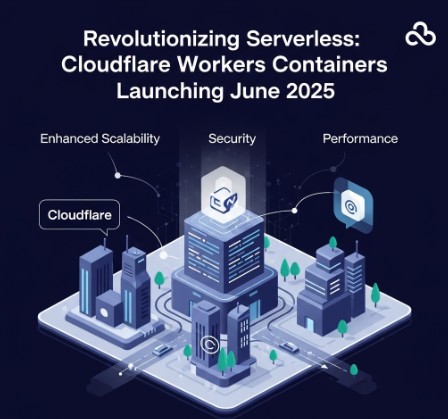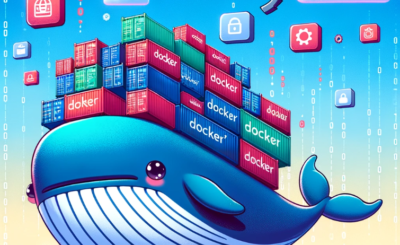The serverless landscape is about to change dramatically. For years, developers have relied on platforms like AWS Lambda and Google Cloud Functions to execute code without managing servers. But these solutions often come with limitations in terms of runtime environments and customization. Enter Cloudflare Workers Containers, a game-changer promising unprecedented flexibility and power. Scheduled for a June 2025 launch, Cloudflare Workers Containers represent a significant leap forward, allowing developers to run virtually any application within the Cloudflare edge network. This article delves into the implications of this groundbreaking technology, exploring its benefits, use cases, and addressing potential concerns.
Table of Contents
- 1 Understanding the Power of Cloudflare Workers Containers
- 2 Building and Deploying Applications with Cloudflare Workers Containers
- 3 Advanced Use Cases for Cloudflare Workers Containers
- 4 Cloudflare Workers Containers: Addressing Potential Challenges
- 5 Frequently Asked Questions
- 5.1 Q1: What are the pricing implications of Cloudflare Workers Containers?
- 5.2 Q2: Will existing Cloudflare Workers code need to be rewritten for containers?
- 5.3 Q3: What container technologies are supported by Cloudflare Workers Containers?
- 5.4 Q4: How does the security model of Cloudflare Workers Containers compare to existing Workers?
- 6 Conclusion
Understanding the Power of Cloudflare Workers Containers
Cloudflare Workers have long been known for their speed and ease of use, enabling developers to deploy JavaScript code directly to Cloudflare’s global network. However, their limitations regarding runtime environments and dependencies have often restricted their applications. Cloudflare Workers Containers overcome these limitations by allowing developers to deploy containerized applications, including those built with languages beyond JavaScript.
The Shift from JavaScript-Only to Multi-Language Support
Previously, the primary limitation of Cloudflare Workers was its reliance on JavaScript. Cloudflare Workers Containers expand this drastically. Developers can now utilize languages such as Python, Go, Java, and many others, provided they are containerized using technologies like Docker. This opens up a vast range of possibilities for building complex and diverse applications.
Enhanced Customization and Control
Containers provide a level of isolation and customization not previously available with standard Cloudflare Workers. Developers have greater control over the application’s environment, dependencies, and runtime configurations. This enables fine-grained tuning for optimal performance and resource utilization.
Improved Scalability and Performance
By leveraging Cloudflare’s global edge network, Cloudflare Workers Containers benefit from automatic scaling and unparalleled performance. Applications can be deployed closer to users, resulting in lower latency and improved response times, especially beneficial for globally distributed applications.
Building and Deploying Applications with Cloudflare Workers Containers
The deployment process is expected to integrate seamlessly with existing Cloudflare workflows. Developers will likely utilize familiar tools and techniques, potentially leveraging Docker images for their containerized applications.
A Hypothetical Workflow
- Create a Dockerfile defining the application’s environment and dependencies.
- Build the Docker image locally.
- Push the image to a container registry (e.g., Docker Hub, Cloudflare Registry).
- Utilize the Cloudflare Workers CLI or dashboard to deploy the containerized application.
- Configure routing rules and access controls within the Cloudflare environment.
Example (Conceptual): A Simple Python Web Server
While specific implementation details are not yet available, a hypothetical example of deploying a simple Python web server using a Cloudflare Workers Container might involve the following Dockerfile:
FROM python:3.9-slim-buster
WORKDIR /app
COPY requirements.txt .
RUN pip install --no-cache-dir -r requirements.txt
COPY . .
CMD ["python", "app.py"]This would require a requirements.txt file listing Python dependencies and an app.py file containing the Python web server code. The key is containerizing the application and its dependencies into a deployable Docker image.
Advanced Use Cases for Cloudflare Workers Containers
The implications of Cloudflare Workers Containers extend far beyond simple applications. They unlock advanced use cases previously difficult or impossible to achieve with serverless functions alone.
Microservices Architecture
Deploying individual microservices as containers on the Cloudflare edge enables high-availability, fault-tolerant applications. The global distribution ensures optimal performance for users worldwide.
Real-time Data Processing
Applications requiring real-time data processing, such as streaming analytics or live dashboards, can benefit from the low latency and scalability provided by Cloudflare Workers Containers.
AI/ML Inference at the Edge
Deploying machine learning models as containers allows for edge-based inference, reducing latency and bandwidth consumption. This is crucial for applications such as image recognition or natural language processing.
Cloudflare Workers Containers: Addressing Potential Challenges
While the promise of Cloudflare Workers Containers is exciting, potential challenges need to be considered.
Resource Limitations
While containers offer greater flexibility, resource constraints will still exist. Understanding the available resources (CPU, memory) per container is vital for optimizing application design.
Cold Starts
Cold starts, the time it takes to initialize a container, may introduce latency. Careful planning and optimization are necessary to minimize this effect.
Security Considerations
Security best practices, including image scanning and proper access controls, are paramount to protect deployed containers from vulnerabilities.
Frequently Asked Questions
Q1: What are the pricing implications of Cloudflare Workers Containers?
A1: Specific pricing details are not yet public, but Cloudflare’s pricing model will likely be based on consumption, factors like CPU usage, memory, and storage utilized by the containers.
Q2: Will existing Cloudflare Workers code need to be rewritten for containers?
A2: Existing Cloudflare Workers written in Javascript will remain compatible. Cloudflare Workers Containers provide an expansion, adding support for other languages and more complex deployments. No rewriting is required for existing applications unless the developer seeks to benefit from the enhanced capabilities offered by the containerization feature.
Q3: What container technologies are supported by Cloudflare Workers Containers?
A3: While the official list is yet to be released, Docker is the strong candidate due to its widespread adoption. Further information on supported container runtimes will be available closer to the June 2025 launch date.
Q4: How does the security model of Cloudflare Workers Containers compare to existing Workers?
A4: Cloudflare will likely adopt a layered security model, combining existing Workers security features with container-specific protections, such as image scanning and runtime isolation.

Conclusion
The impending launch of Cloudflare Workers Containers in June 2025 signifies a pivotal moment in the serverless computing landscape. This technology offers a powerful blend of speed, scalability, and flexibility, empowering developers to build and deploy sophisticated applications on the global Cloudflare edge network. While challenges remain, the potential benefits, especially enhanced customization and multi-language support, outweigh the hurdles. By understanding the capabilities of Cloudflare Workers Containers and planning accordingly, developers can position themselves to leverage this transformative technology to build the next generation of serverless applications. Remember to stay updated on official Cloudflare announcements for precise details on supported technologies and best practices. Thank you for reading the DevopsRoles page!


